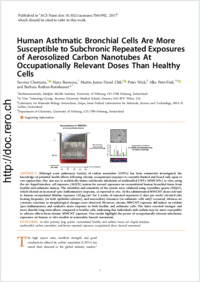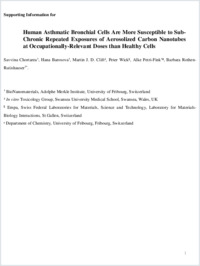Human asthmatic bronchial cells are more susceptible to subchronic repeated exposures of aerosolized carbon nanotubes at occupationally relevant doses than healthy cells
- Chortarea, Savvina BioNanomaterials, Adolphe Merkle Institute, University of Fribourg, Switzerland
- Barosova, Hana BioNanomaterials, Adolphe Merkle Institute, University of Fribourg, Switzerland
- Clift, Martin J. D. In Vitro Toxicology Group, Swansea University Medical School, Wales, U.K.
- Wick, Peter Laboratory for Materials-Biology Interactions, Empa, Swiss Federal Laboratories for Materials, Science and Technology, St Gallen, Switzerland
- Petri-Fink, Alke BioNanomaterials, Adolphe Merkle Institute, University of Fribourg, Switzerland - Department of Chemistry, University of Fribourg, Switzerland
- Rothen-Rutishauser, Barbara BioNanomaterials, Adolphe Merkle Institute, University of Fribourg, Switzerland
-
15.05.2017
Published in:
- ACS Nano. - 2017, vol. 11, no. 8, p. 7615-7625
air−liquid interface
hazard assessment
in vitro primary lung system
multiwalled carbon nanotubes
occupational doses
reconstituted healthy and asthma tissue
subchronic repeated exposure
English
Although acute pulmonary toxicity of carbon nanotubes (CNTs) has been extensively investigated, the knowledge of potential health effects following chronic occupational exposure is currently limited and based only upon in vivo approaches. Our aim was to realistically mimic subchronic inhalation of multiwalled CNTs (MWCNTs) in vitro, using the air–liquid interface cell exposure (ALICE) system for aerosol exposures on reconstituted human bronchial tissue from healthy and asthmatic donors. The reliability and sensitivity of the system were validated using crystalline quartz (DQ12), which elicited an increased (pro-)inflammatory response, as reported in vivo. At the administrated MWCNT doses relevant to human occupational lifetime exposure (10 μg/cm2 for 5 weeks of repeated exposures/5 days per week) elevated cilia beating frequency (in both epithelial cultures), and mucociliary clearance (in asthmatic cells only) occurred, whereas no cytotoxic reactions or morphological changes were observed. However, chronic MWCNT exposure did induce an evident (pro-)inflammatory and oxidative stress response in both healthy and asthmatic cells. The latter revealed stronger and more durable long-term effects compared to healthy cells, indicating that individuals with asthma may be more susceptible to adverse effects from chronic MWCNT exposure. Our results highlight the power of occupationally relevant subchronic exposures on human in vitro models in nanosafety hazard assessment.
- Faculty
- Faculté des sciences et de médecine
- Department
- Département de Chimie
- Language
-
- English
- Classification
- Biological sciences
- License
- License undefined
- Identifiers
-
- RERO DOC 288910
- DOI 10.1021/acsnano.7b01992
- Persistent URL
- https://folia.unifr.ch/unifr/documents/305457
Other files
Statistics
Document views: 84
File downloads:
- fin_hab.pdf: 205
- fin_hab_sm.pdf: 115

